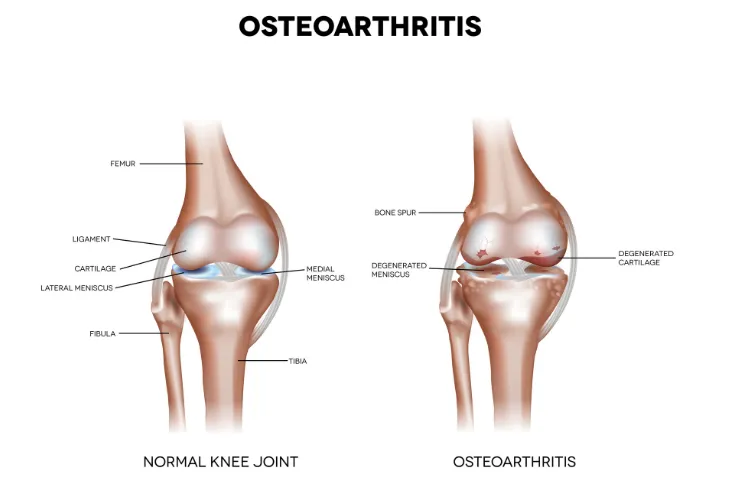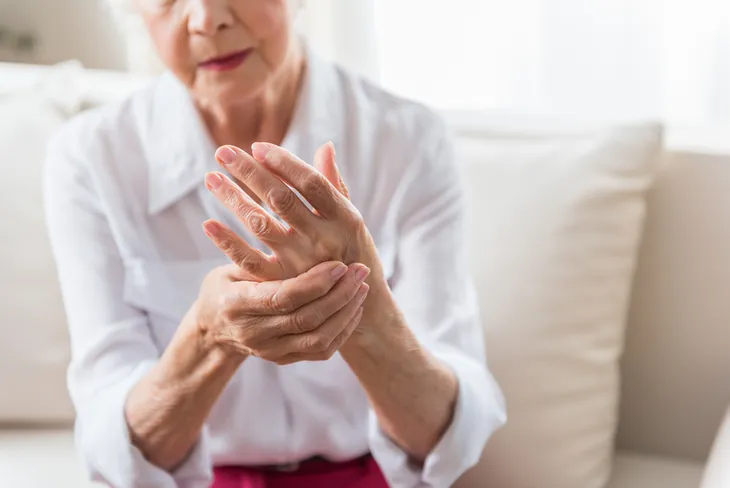Joint pain is a common ailment that can affect anyone, but particularly older adults or people with arthritis. This type of pain is often felt in the hands, feet, hips, knees, or spine. It can be constant or come and go in waves, says Cleveland Clinic. While it might not seem all that serious, joint pain can be debilitating and greatly affect a persons quality of life.
In addition to causing pain, it can affect the function of the joint and limit a person’s ability to do even basic tasks throughout their day. To help ease discomfort and regain mobility, here are some tips on how to get joint pain under control…
What Causes Joint Pain?
Joint pain is a common ailment that can occur for several different reasons. It could be a result of a condition like arthritis, an injury to the joint, or simply a side effect of getting older. While there are many potential causes, the Cleveland Clinic has compiled a list of the most common. Determining the cause behind joint pain is imperative to getting treatment and hopefully resolving the pain altogether.
Osteoarthritis is a common type of arthritis that happens over time when the protective cushion between the bones wears away. This causes the joints to become sore and stiff. Another common cause is the chronic condition, rheumatoid arthritis. Cleveland Clinic says this form of inflammatory arthritis causes pain and swelling, and often results in a deformity in the fingers and wrists. Gout may also result in joint pain (oftentimes the big toe) when crystals in the body form in the joints resulting in severe pain and swelling.
Other common causes are bursitis which is from overuse in the hip, knee, elbow, or shoulder. Viral infections, rash, or fever can impact joint movement. Injuries like broken bones or sprains, as well as tendinitis, which is an inflammation of the tendons or flexible bands that connect the bone and muscle, writes the source.
Symptoms Associated with Joint Pain
Joint pain is a wide ranging symptoms because it can be mild or to the point where it’s debilitating and affecting a person’s everyday life. “Without cartilage, bones rub directly against each other as the joint moves,” says the Cleveland Clinic. Even just the thought of that hurts! While joint pain itself is a symptom, there are often other symptoms that occur alongside it.
The Cleveland Clinic lists the following as symptoms of joint pain that are cause for concern:
- Swelling
- Numbness
- Stiff or enlarged joint
- Noisy joints, or clicking, grinding, or snapping sounds when moving the joint
- Painful movement
- Difficulty bending or straightening the joint
- Loss of motion
- A red and hot and swollen joint (this should be evaluated immediately)
Manage Weight
Being overweight adds a lot of strain onto a persons joints, especially if they are already injured or damaged. Losing excess weight can help reduce joint pain, particularly people with arthritis. “For people who are overweight or obese, losing weight reduces stress on joints, particularly weight bearing joints like the hips and knees,” writes the Centers for Disease Control and Prevention (CDC).
The same source notes that even a loss of 10 to 12-pounds can make a huge difference in pain reduction and improve physical function. No matter what a person’s age is, there are plenty of arthritis and joint-friendly forms of exercise, such as walking and swimming. Combining regular exercise with a healthy diet can assist in losing weight.
Stay Active
When struggling with joint pain, being active might be the last thing a person wants to do, but it can actually help provide relief. Not only that, but exercise is a much more simple and inexpensive way to treat arthritis pain. There’s no paying for medication or fancy treatments. All it takes is putting on a pair of shoes and going for a walk each day.
According to the CDC, alongside reducing pain, physical activity can improve function, mood, and quality of life for people with arthritis. It will also help to improve sleep and support bone health, brain health, and weight control. Additional benefits include a reduced risk of other chronic diseases, such as heart disease and diabetes. For those who already have them, it can help manage them better.
The Physical Activity Guideline for Americans recommends all adults get 150-minutes of moderate physical activity each week.
Eat Healthy
Continuing with weight management, a key part of that is to eat healthy. The Arthritis Foundation recommends focusing on a balanced, healthy diet that includes plenty of vegetables, fresh fruit, whole grains, and lean proteins (i.e. beans, poultry, and fish). In addition to that, stay away from highly processed foods, red meat, and sugary drinks.
Eating healthy not only assists with weight loss, but certain foods can help reduce joint pain. Ariana Fiorita, RDN, LD, IFNCP, talked to the Cleveland Clinic about what foods are best for joint pain. Fiorita advises following the Mediterranean diet which has numerous health benefits, as well as incorporating fish oil and more cruciferous vegetables. Turmeric and ginger provide anti-inflammatory benefits, plus green tea may have some impact on arthritis-related immune responses.
Assistive Devices
Supportive aids can go a long way in preventing further damage or injury. They can also assist in mobility when the pain begins to interfere with daily activities. There are many options available, it all depends on the need. You can use a brace, cane, or even just an orthotic device in the shoe to help support the joint and ease any movement, says the Cleveland Clinic.
You’ll need to see a doctor to get a proper diagnosis and then an occupational therapist or social worker to assist in choosing what option would work best for you.
Take Medication
While there are many lifestyle or at-home remedies people can try to reduce their joint pain, if the pain is severe, these should all be done in addition to taking any medication that has been prescribed by a doctor. There are many prescription and over-the-counter medications a doctor may recommend to control inflammation and pain.
However, the Arthritis Foundation notes that if any of these medications are causing side effects that hinder or deter you from taking them, or if you’re having trouble affording them, talk to your doctor. They may be able to prescribe alternate medications or assist with payment options.
Mindful Meditation
Ever heard the saying, “mind over matter?” It turns out there is some truth to this. Our brain can be used as a powerful tool against pain, specifically how we experience pain. Now this isn’t to say that pain is just “in our heads,” but there are some techniques that can be used to help us better manage this pain. One prime example of this is mindful meditation.
Mindful meditation is a mental exercise that helps individuals focus their mind and body on the “now” and being in the moment to acknowledge thoughts, feelings, and sensations. “Instead of paying attention to unpleasant thoughts about pain, individuals can focus on their breathing, body sensations and relaxing their body,” writes Arthritis Society Canada. “Mindfulness helps us think about pain with less fear and more acceptance, allowing us to live a good, healthy lifestyle, despite having pain.”
Stretching
Stretching is something that often gets overlooked. It’s an important addition to exercise, both before and after. Plus, it’s something we should all do on a daily basis, particularly people who sit for long periods of time. The benefits are even greater for anyone experiencing joint pain because according to the Arthritis Foundation, stretching helps lubricate the joints and enhance the range of motion.
Before getting into stretching or any new exercise plan, it’s first important to talk to your doctor. Make sure it’s not only safe, but appropriate for you. You should also understand the difference between the two types of stretching: dynamic and static. “Dynamic stretching involves moving through a range of motion to warm up joints and muscles and increase flexibility,” explains Creakyjoints.org. Static stretching involves holding a stretch for 30 to 60-seconds. There may be mild tension, but shouldn’t be painful.
The Arthritis Foundation warns not to stretch a cold muscle. You should only perform “static stretching” after a 5 to 10-minute warm up, says Amy Ashmore, PhD, an exercise physiologist with the American Council on Exercise. A muscle that has warmed up can stretch longer and endure more.
Hot and Cold Therapy
While this isn’t going to cure or fix the problem, applying a hot or cold compress to the area for short periods of time can help relieve joint pain temporarily. Depending on the cause of the joint pain, particularly if it’s the result of an injury, it may be recommended to do this for short periods, several times a day.
Another form of this therapy that can provide relief is to soak in a warm bathtub.
 Shutterstock/HENADZI KlLENT
Shutterstock/HENADZI KlLENTProtect Your Joints
This might seem like an obvious statement, but protecting our joints is extremely important. It’s not something many people think of until they are already experiencing joint pain. While they are strong and allow us to move our body, our joints are still susceptible to injury which can worsen any already existing joint pain or conditions like arthritis.
To protect the joints from further pain, stick to low risk activities like walking, biking, and swimming. These are all low-impact activities that won’t put a lot of pressure on the joints, either by twisting or stressing them in general. The CDC warns that injuries to the joints from sports, work, or vehicle accidents can increase a persons risk of developing osteoarthritis, so it’s imperative we take steps to avoid or minimize joint injuries. “Actions include wearing protective equipment, seatbelts, and avoiding repetitive motion joint damage,” writes the source.
When to See a Doctor
While joint pain itself isn’t an emergency, if it leaves a person unable to get through even the simplest daily activities, it might be time to talk to a doctor. A doctor can help diagnose the cause behind this pain which hopefully leads to treatment and a pain management plan. The Cleveland Clinic advises contacting a doctor if the joint pain is accompanied by a fever, unexplained weight loss, or if the pain leaves a person unable to walk properly.
A doctor will likely ask a series of questions in order to make their diagnosis, such as if there have been any previous injuries, when the pain began, family history, and what type of pain is being experienced. You might have to get some X-rays to look for signs of injury to the surrounding muscles, tendons, and ligaments. “X-rays can show if there is joint deterioration, fluid in the joint, bone spurs, or other tissues that may be contributing to the pain,” writes the source. A blood test may also be required to confirm a diagnosis or rule out other diseases.














